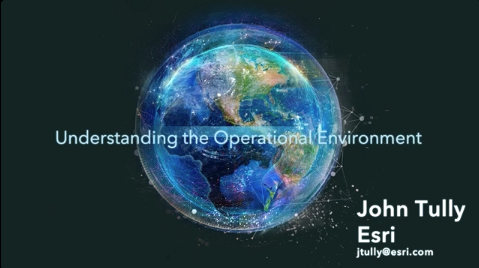By: Bryan Raymer, Account Manager at Esri
The DGI conference is the Digital Government Institute’s (DGI) premier annual event, and DGI 2021 was no exception. Hosted virtually due to the COVID‑19 pandemic, it attracted attendees from more than 40 countries. Presentations were given by the world’s leading government and commercial geospatial experts from AGO, NATO, NGA, UK’s National Centre for Geospatial Intelligence, UK MOD, and others. Throughout all these presentations, there were some dominant topics: space activities, the increasing volume of data, COVID‑19, and artificial intelligence (AI)/machine learning (ML). While not all executive speakers addressed these topics in the same way, they all talked about how these issues either affected their mission in 2020 or caused them to respond by strengthening their mission capabilities moving forward.
Key Topics
COVID‑19: Every presenter talked about how the COVID‑19 pandemic affected how Intel analysts conducted and accomplished their mission. Overall, COVID‑19 was a force multiplier or accelerant. The pandemic forced the agencies to change the way they worked. They had to establish new policies to allow employees to work from home while still maintaining safety and meeting mission security requirements. While all executive speakers saw COVID‑19 as a challenge, it ultimately created new opportunities that allowed all the agencies to grow their capabilities.
Space Activities: Most of the intelligence agencies’ speakers discussed how space activities were growing exponentially due to the influx of commercial sensors, such as HawkEye 360 and BlackSky, over the last decade. This growth has forced agencies to realign to leverage these activities. National Geospatial-Intelligence Agency (NGA) Support Team (NST) Chief David Hoerner talked about how space capabilities caused NGA to look at space from both a strategic and a tactical perspective. The NGA NST team still has a space mission focus but now also has a tactical geospatial intelligence (GEOINT) mission to support the US Space Command and all its GEOINT needs.
Data Volume: The proliferation of space-based and terrestrial sensors and increased access to open-source data have created a monumental rise inaccessible data. Despite the increase in data, agencies are not budgeted to get an increase in billets, so they will be forced to analyze exponentially more data without additional human assets. To make use of this new data, agencies are looking at new tools, techniques, and policies that will allow them to automate some of their data analysis before data ever reaches their analysts. These initiatives have caused nearly all Defense and Intel entities to increase their efforts in the use of AI and ML techniques.
AI/ML: Many of the groups expounded on how they needed to increase AI and ML capabilities to leverage all the newfound data. While I agree with this, I believe the majority of the executives were most excited about how to automate data ingestion, data filtering, and data dissemination. By automating these resource-intensive activities, it would free up their analyst and data scientist to make deeper analytical conclusions and focus on how to automate more complex analytical tools.
Esri Perspective: Esri had two presentations at this conference, and both touched on each of these topics. Both Esri’s presentations recommended breaking down the vast amounts of data and complex analytical concepts into easier-to-understand concepts and to visualize and share them in a digital world. Presenter John Tully talked about how implementing a true enterprise GIS would allow units, agencies, and even coalitions to integrate and share all GEOINT data in a common operating picture (COP). He said this is because all things are tied to a specific space and time and thus can be visualized and analyzed in a common integrated framework. By doing so, it would allow analysts and agencies to improve the efficiency of how they visualize, analyze, and disseminate data and results. The efficiencies gained by implementing a truly integrated GIS not only increase the ability to operate off a common picture but also allow analysts to build and incorporate new GIS tools to enable automation and deeper analytical results.
Conclusion
My main takeaway from the DGI conference is that we are at the precipice of great change within the GEOINT community. Over the next decade, our day-to-day activities will change considerably, and our techniques and partnerships will have to evolve to allow us to continue to fulfill our mission. We geospatial professionals will continue to develop new tools and workflows to increase our capacity to analyze the massive amounts of new data and resources that we have access to in order to provide greater insights into the world.

